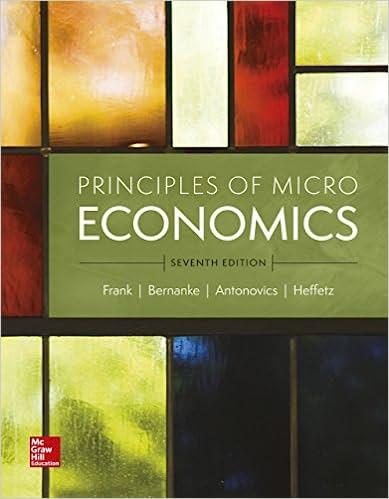Question
Question 1 What is the definition of the marginal cost (MC)? a. Cost that does not change with the amount of output b. Cost of
Question 1
What is the definition of the marginal cost (MC)?
a. Cost that does not change with the amount of output
b. Cost of a typical unit of output
c. Cost of making a company's entire amount of goods
d. Cost of an additional unit of output
e. Average of only the costs that vary with output
Question 2
Suppose there is a firm known as Rose Industries that produces a product known as "Okjians". At q=0, the total cost is $100 and then increases by $35 for each additional unit produced. What is the FC?
a. $0
b. $20
c. $35
d. $100
e. Not enough information
Question 3
What is the definition of the fixed cost (FC)?
a. Cost that does not change with the amount of output
b. Cost of a typical unit of output
c. Cost of making a company's entire amount of goods
d. Cost of an additional unit of output
e. Average of only the costs that vary with output
Question 4
What is the definition of average total cost (ATC)?
a. Cost does not change with the amount of output
b. Cost of a typical unit of output
c. Cost of making a company's entire amount of goods
d. Cost of an additional unit of output
e. Average of only the costs that vary with output
Question 5
Again, consider the firm known as Rose Industries. At q=0, the total cost is $100 and then increases by $35 for each additional unit produced. For q=10, what is the ATC?
a. $0
b. $20
c. $35
d. $45
e, $100
Question 6
Suppose we have another firm known as the Sabrina Corporation which makes a product known as "Schalks". Suppose that its FC=$2,000 and its TC=$5,000 and its AVC=$60. What is the ATC?
a. $20.50
b. $70
c. $80
d. $100
e. Not enough information
Question 7
Consider the following information. Suppose FC=$2,000. Further suppose that when q=19 then AVC=$500 and when q=20 then ATC=$600.
What is the MC for the 20thunit?
a. $50
b. $100
c. $500
d. $1,000
e. $2,000
Question 8
Consider the following information from the previous problem: FC=$2,000 and when q=19 then AVC=$500 and when q=20 then ATC=$600.
If the firm decides to make 20 units (q=20), what is the MR at q=20?
a. $50
b. $100
c. $500
d. $1000
e. Not enough information
Question 9
Suppose you go out to dinner. But you are really hungry when you order and buy too much food. By the time you get to dessert, you are stuffed. You cannot get a refund on the dessert, and it will rot before you can take it home. According to the lecture, you should eat the dessert anyway.
True
False
Question 10
Which of the following might explain why a competitive market has very few "real world" examples?
a. A competitive market is made up of firms with identical goods
b. A competitive market consists only of a few firms
c. A competitive market has barriers to entry which prevent other firms from entering
d. The firm's price is at least partly dependent on the demand for its product
e. A competitive market consists of many firms
Step by Step Solution
There are 3 Steps involved in it
Step: 1

Get Instant Access to Expert-Tailored Solutions
See step-by-step solutions with expert insights and AI powered tools for academic success
Step: 2

Step: 3

Ace Your Homework with AI
Get the answers you need in no time with our AI-driven, step-by-step assistance
Get Started


